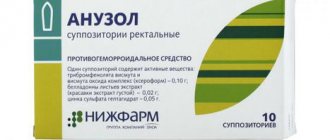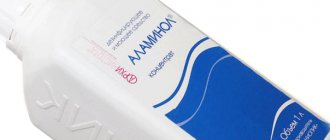Composition, release form
Methylene Blue - In Latin, Methylenum coeruleum is a dye. Other names for this substance are known: Methylene blue, Methyl blue. When dry, it appears as dark green crystals with a characteristic bronze luster. The active ingredient is methylthioninium chloride.
The drug is used mainly in the form of an alcohol solution. It contains alcohol and methylene blue itself. A weaker aqueous solution may be used. Its composition is represented by Methyl blue and purified water.
A special solution is prepared for intravenous administration. Its dominant component is Methylene blue (solution with a concentration of 1%). Glucose (25%) is used as another active ingredient. Additional components are also included - stabilizer and prolongator.
The main form of release of the alcohol preparation is glass bottles with a solution with a concentration of 1%. Their average volumes are 10-15 ml.
Methylene blue
Aqueous ready-made solutions of Methylenum coeruleum are produced in glass bottles of 10, 25, and 50, 100 ml. A special solution is intended for intravenous administration, contained in ampoules of 20-50 ml.
Mechanism of action
The effectiveness of Methylene blue, which is a representative of the group of antiseptics, is explained by its rapid destructive effect on harmful pathogenic microflora.
The basic mechanism of action of the drug is due to the activity of its components. They are able to bind bacterial proteins upon contact and then remove them almost instantly.
Pathogenic microorganisms die as a result of such interaction, which prevents the risk of their penetration into the skin tissue. The active ingredients of an antiseptic solution, when applied externally, are not able to enter the bloodstream, so they are not absorbed by the body.
An alcohol solution produces an antiviral, disinfectant, antimicrobial, analgesic, antibacterial effect, and also helps accelerate the regeneration of damaged skin tissue. The aqueous analogue is used as a fast-acting antidote.
The instructions for the drug indicate that it can be used for diagnostic purposes to study kidney function, since after internal use of the drug, the urine turns blue.
The substance is excreted in urine and bile mainly in an uncolored form, although it is possible that some amount may be excreted unchanged.
Main properties of the product: pharmacology and pharmacokinetics
Methylene blue is a solution for external use, belonging to the group of fast-acting antiseptics. Use the solution to treat diseased skin areas and deep wounds. An effective remedy for adults and children that combats burns of varying degrees.
Methylene blue belongs to the group of antiseptic agents with a rapid effect on pathogenic microflora. The main mechanism of action of the product is based on the reaction of the active components of the alcohol solution with bacterial microorganisms: on the upper layers of the epidermis, the substances bind to bacterial proteins (on the surface of the wound) and quickly remove them. Thanks to this interaction, pathogenic microorganisms die without entering the human body. After using the solution, the main active ingredients are not absorbed by the body and do not enter the bloodstream.
According to the instructions, the solution has a disinfecting effect. The product helps restore damaged areas of the skin due to thermal or chemical exposure. Active components supply hydrogen ions to damaged tissues, promoting rapid regeneration of the epidermis. A solution obtained by diluting with water is used as a fast-acting antidote. According to the international classification of diseases ICD-10, burns, wounds, and bacterial infections belong to the anatomical-therapeutic-chemical group and are effectively treated with a solution of Methylene blue.
Pharmacodynamics and pharmacokinetics
This product belongs to the antiseptic category . Its action is based on the ability of the drug to interact with certain groups of substances of gram-positive bacterial cells , their proteins and mucopolysaccharides with the formation of poorly soluble and slowly ionizing complexes.
What else to read Polyoxidonium for herpes: treatment regimen, reviews and complete information about the drug
The drug has redox properties and is able to play the role of a donor of hydrogen ions in the body. Thanks to this, it can be used as an antidote for some poisonings.
The drug does not enter the systemic circulation when applied topically. When taken internally, the drug is excreted through the kidneys.
In addition, this product can be used for aquarium fish. It prevents the proliferation of ichthyophthirius, trichodin, aeromonads, myxobacteria, chilodonella, costia, and pseudomonads. Methylene blue for the aquarium is also used to improve acid metabolism in the tissues of fish if they have been transported, preparing antibacterial food, processing eggs and fry.
However, when using it, the water turns blue, which causes the equipment and accessories in the aquarium to get dirty and makes it difficult to monitor your pets. Therefore, it is advisable to use this product in a separate container.
Negative effects of methylene blue on aquarium fish
Despite its obvious usefulness, methylene blue has serious disadvantages:
- reduction in the efficiency of the biofilter,
- negative impact on the aquarium flora,
- change in color of light decorative elements and soil.
Methylene blue completely destroys the biological environment. Its use has a negative effect on beneficial bacteria and microorganisms.
To prevent the negative effects of the drug, it is recommended to remove all light parts from the aquarium.
If one individual gets sick, and the infection has not yet spread to the entire aquarium, then the infected fish are placed in separate containers with a solution.
Indications for use
Methylene blue has a wide range of applications with high disinfecting and disinfecting effectiveness.
This product in the form of solutions has the following indications:
- pharyngitis;
- stomatitis;
- gingivitis;
- follicular tonsillitis;
- thrush;
- laryngitis;
- caries;
- pyoderma;
- minor thermal burns;
- sycosis;
- aphthoses of the mucous membranes;
- herpes;
- wounds;
- eczema;
- furunculosis;
- insect bites;
- urethritis;
- cystitis;
- intoxication.
An aqueous solution for external treatment of mucous membranes and skin is permitted from the age of 1 year.
Overdose
The occurrence of side effects occurs against the background of a violation of the dosage of the drug. Damage caused by the drug manifests itself in problems with the bladder, kidneys, or gastrointestinal tract. Patients with overdose experience vomiting, severe chills, elevated body temperature and anemia.
An overdose occurs against the background of frequent use of the treatment product. Alcohol dries out the skin, resulting in cracks and new wounds appearing on the weakened epidermis. In case of an overdose of the solution, standard therapy (symptomatic) is prescribed. Any side effects are the reason to discontinue the drug or replace the alcohol solution with an analogue.
Contraindications and side effects
Methylene blue is a drug with a minimal list of contraindications. For external use, its use is prohibited if an allergic reaction is detected and in children under 1 year of age. When treating mucous membranes, the solution is applied only to problem areas.
The following conditions are prohibited for internal use of the drug:
- renal failure;
- lactation period;
- pregnancy;
- manifestation of individual intolerance.
In rare cases, side effects are possible:
- nausea;
- pain in the abdominal area;
- anemia;
- allergic rash;
- swelling;
- burns of mucous membranes.
It is advisable to check the body's reaction to the drug before starting treatment with Methylene blue. You can go to a medical institution to see an allergist who will do the necessary testing.
What about blue wash?
I don’t know whether you’ve encountered this or not, but I only saw it a couple of times, and only when I was visiting my grandmother. My mother, no matter how conservative, did not use blue when washing. But my grandmother added.
Nowadays in markets and hardware stores they sell so-called blue by weight, but no matter how much I asked, no one could answer me what is included in its composition. They simply shoved transparent plastic bags with dark crystals into their hands without any inscriptions or instructions.
I had to figure it out myself. Still, methylene blue and blue from a hardware store - are they the same thing or not?
Blue is added to washing water either to color items or as an optical brightener. It sounds strange, but take a look at my article about bleaches, it is explained in detail.
Modern bluing may contain highly soluble dyes that ensure uniform coloring of the fabric:
- Paris blue;
- Prussian blue;
- indigo carmine;
- blue aniline dyes
- and insoluble dyes that give an uneven color: ultramarine and insoluble Paris blue.
Just like blue aniline dyes, methylene blue is included. Thus, store-bought blue is a collective name for several dyes. They can be used to dye or add color to clothing. Or tint and visually update initially blue things, for example, jeans.
Dilution of Methylene Blue
A crystalline preparation of Methyl blue is more accessible. It is stored in a tightly closed glass container.
Dilution sequence for Methylene blue:
- If you want to make the most commonly used aqueous solution of the drug, having a concentration of 1%, measure out 10 g of powder.
- Pour 1 liter of boiling water cooled to warm into a glass container.
- Pour the prepared powder into it while vigorously kneading with a wooden spatula.
- When all the crystals have dissolved, strain the solution into another glass vessel using a gauze cloth folded in 6 layers.
During work, protect your hands with rubber gloves to avoid staining the skin.
Instructions and doses
Methylene blue is an effective antiseptic used for a variety of diseases.
Thrush, aphthous stomatitis
Use a one percent aqueous solution, soak a cotton swab with it, and carefully treat each sore spot. Before starting the procedure, it is necessary to dry the oral cavity from saliva with a sterile cotton swab.
For adults, the session is practiced every 3-4 hours. For children over one year of age, the treatment is carried out 3-4 times a day, timing the procedure after meals. If the child is breastfed, the mother’s nipples should be lubricated with the solution, which will protect the baby’s mucous membranes from possible damage.
Stomatitis caused by herpes
When rashes appear due to exacerbation of herpes, the blisters located on the mucous membranes in the mouth and the inside of the lips are treated three times a day with an aqueous solution of Methyl Blue. The skin area around the lip border is lubricated from the outside with an alcohol analogue, covering the healthy area next to the rash.
When large lesions appear, adults are advised to rinse their mouths with an aqueous solution in the morning and evening.
The effectiveness of Methylene blue for stomatitis of various natures is manifested in several directions:
- disinfection and drying of painful, weeping ulcers;
- slowing down the development of pathogenic bacteria;
- healing of microcracks;
- elimination of inflammatory foci and purulent processes.
After completing the procedures involving the application of Methyl Blue to the internal surfaces of the oral cavity, it is not recommended to consume food or drinks for 30-40 minutes. During the entire treatment course, spicy, hot, overly sour foods, which can further irritate the affected oral mucosa, are excluded from the menu.
With systematic use of the drug, healing of painful ulcers is observed 3-4 days after the start of treatment. Patients experience relief after 2-3 procedures.
Wounds, burns
If skin lesions are detected, it is recommended to use an alcohol solution based on Methylene blue, which has pronounced antiseptic and disinfecting properties.
The affected area of skin is carefully washed with cool, pre-boiled water. Soak a cotton swab in the preparation and carefully apply it to the affected area. Repeat treatment sessions 3-4 times a day.
Staphylococcus
When ulcers appear on the skin caused by the development of Staphylococcus aureus, an alcohol-based solution of Methylene blue is successfully used to treat the affected areas. Soak a cotton swab with the product and distribute it generously onto each purulent formation. Sessions are practiced 3-4 times a day. The alcohol composition is not used on mucous membranes.
Table. Methylene Blue Dosages:
| Disease | Solution concentration | Application |
| Cystitis, urethritis | An aqueous solution with a concentration of 0.02% is required. The powder dissolves in filtered water in a ratio of 1:5000. | The male urethra is washed using a special catheter. Women with cystitis are recommended to rinse the vagina using a syringe. |
| Pharyngitis, laryngitis, sore throat | Prepare an aqueous solution of Methylene blue. The recommended concentration is 0.02%. | They practice gargling a sore throat three times a day. |
| Caries | In order to prevent and reduce the rate of caries development, a weak solution of the drug is used - 0.02%. | At the first signs of caries development, in the morning and evening, rinse teeth with a disinfecting solution for 2-3 minutes. |
| Gingivitis | You will need a one percent ready-made aqueous solution. | Gums affected by the inflammatory process must be lubricated with the drug three times a day. |
| Poisoning caused by carbon monoxide, dangerous cyanides, hydrogen sulfide. | A water-based Methyl Blue preparation is used with a concentration of 1%. | The healing ready-made solution is used intravenously in a medical facility, 50-100 ml. |
| Poisoning with nitrites, toxic methemoglobin-forming substances, aniline, as well as derivatives of this organic compound. | An aqueous one percent solution of the drug is shown. | For intravenous administration, it is calculated that for every 1 kg of weight, 0.1-0.15 ml of solution will be required. |
Coloring
When using Methyl Blue, a slight bluish tint to the mucous membranes or skin may occur, which is not dangerous. When the concentration is properly selected, the drug does not have a toxic effect .
After cessation of treatment, after a few days the skin acquires its natural color.
Opinions of doctors and patients
Here's what doctors and patients with experience of using it say in their reviews of Methylene Blue:
I believe that civilized Europe does not consider Methylene blue as a good antiseptic for the treatment of mucous membranes of the tonsils and oral cavity. The drug should only be used to kill infections on the skin. However, it confirms the usefulness of injections of solutions as an antidote and diagnostic tool.
Doctor Komarovsky E. O. (Ukraine)
There was no point in treating genital herpes with anything, only methylene blue helped get rid of the sores. I cauterized it with a solution of alcohol every 4 hours, and as a result, I have been in remission for 2 years.
Alena E. 40 years old
Previously, there was no trace of any antiseptics other than brilliant green and blue. Chickenpox, rubella in children, even small measles were treated by cauterizing the blisters. An excellent remedy: on my face and my daughters’ face, as well as on my body, not a single pockmark (scar) has formed from a sore wound.
Olga K. 59 years old
When the skin cracks due to eczema, I always apply blue, because I am allergic to almost all medicinal solutions. Then I lubricate it with vegetable oil ointment and mummy. Heals quickly.
Sergey E. 30 years old
Doctors for the most part treat treatment with caution, and patients have only a favorable opinion about the remedy.
Substitutes
If necessary, you can select products from the pharmacy chain that are similar in healing characteristics to Methylene blue.
Table. Substitutes for Methyl Blue:
| Name of the drug | a brief description of |
| Antisept | The drug demonstrates pronounced disinfectant and antiseptic qualities. Recommended for treating skin. |
| Askosept | Has a beneficial anti-inflammatory effect in pharyngitis, laryngitis. |
| Biosept | Belongs to the group of strong antiseptics used to disinfect the skin and treat purulent lesions. |
| Diamond green | It is one of the most common antiseptics that effectively treats a variety of skin lesions. |
| Vitafarm | When used externally, it effectively disinfects the skin. Has bactericidal and antiviral effects. |
| Hydroperite | The active ingredient of this strong antiseptic is urea peroxide. Treats sore throat, stomatitis, wounds. |
| Potassium permanganate | A similar antiseptic with strong oxidizing properties is used in urology, gynecology, and for the treatment of skin lesions. |
| Kutasept | This disinfectant solution has bactericidal, fungicidal, antiviral characteristics. |
| Medasept | It has a pronounced disinfectant and antiseptic effect. |
| Sodium tetraborate | It is highly effective against candidiasis, having bacteriostatic activity. |
| Hydrogen peroxide | This common antiseptic belongs to the group of antioxidants with a hemostatic effect. |
| Septile Plus | The active component of the drug is ethanol. When used externally, it has a detrimental effect on both bacteria and viruses. |
| Pharmasept | Disinfects and disinfects the skin. |
| Chlorophyllin | Effectively treats sore throat, purulent wounds, burns. |
Storage conditions and periods
At home, it is recommended to keep the bottle with the prepared Methyl Blue solution in a dark place at temperatures up to 25 °C.
The maximum shelf life of alcohol products is 2 years. For the aqueous version of the drug, this figure is half as much.
Ready-made dosage forms after opening the vials are allowed to be used for 10-12 days.
Recognized in alternative medicine, Methylene blue is an antiseptic that helps in the treatment of stomatitis of various natures, skin lesions, herpes, and inflammatory processes.








